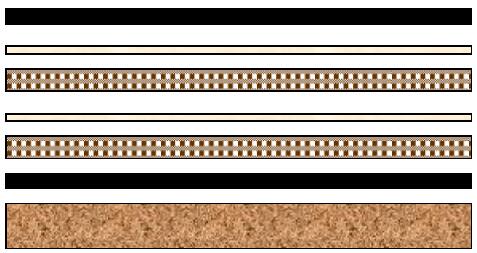Definition of PCB high frequency board
High frequency board refers to the special circuit board with high electromagnetic frequency, which is used in the field of high frequency (frequency greater than 300MHz or wavelength less than 1m) and microwave (frequency greater than 3GHz or wavelength less than 0.1M). It is a circuit board produced by using some processes of ordinary rigid circuit board manufacturing method or special treatment method on microwave substrate copper clad laminate. Generally speaking, a high-frequency board can be defined as a circuit board with a frequency above 1GHz.
With the rapid development of science and technology, more and more equipment designs are applied in the microwave frequency band (> 1GHz) or even in the millimeter wave field (30ghz), which also means that the frequency is higher and higher, and the requirements for the substrate of circuit board are higher and higher. For example, the substrate material needs to have excellent electrical properties and good chemical stability. With the increase of power signal frequency, the loss on the substrate is very small, so the importance of high-frequency plate is highlighted.

Application field of PCB high frequency board
2.1 mobile communication products, intelligent lighting system
2.2 power amplifier, low noise amplifier, etc
2.3 power divider, coupler, duplexer, filter and other passive devices
2.4 high frequency of electronic equipment is the development trend in the fields of automobile anti-collision system, satellite system, radio system and so on.
3, Classification of high frequency board
3.1 powder ceramic filled thermosetting materials
A. PCB high frequency board Manufacturer:
Rogers 4350b / 4003c
Arlon's 25N / 25FR
Taconic's TLG series
B. PCB high frequency board Processing method:
The processing process is similar to that of epoxy resin / glass woven fabric (FR4), but the plate is brittle and easy to break. When drilling and Gong plate, the service life of drilling nozzle and Gong knife should be reduced by 20%.
3.2 PTFE (polytetrafluoroethylene) material
A: PCB high frequency board Manufacturer
1 Rogers ro3000 series, RT series, TMM series
2. AD / AR series, isoclad series and cuclad series of Arlon company
3 RF series, TLX series and tly series of Taconic company
4 f4b, f4bm, f4bk and tp-2 of Taixing microwave
B: Processing method
1. Cutting: the protective film must be reserved to prevent scratch and indentation
2. Drilling:
2.1 use new drill nozzles (standard 130), one by one is the best, and the presser foot pressure is 40psi
2.2 the aluminum sheet is the cover plate, and then the PTFE plate is tightened with 1mm melamine backing plate
2.3 blow out the dust in the hole with an air gun after drilling
2.4 use the most stable drilling rig and drilling parameters (basically, the smaller the hole is, the faster the drilling speed is, and the smaller the chip load is, the smaller the return speed is)
3. Hole treatment
Plasma treatment or sodium naphthalene activation treatment is conducive to pore metallization
4. PTH copper precipitation
4.1 after micro etching (the micro etching rate has been controlled by 20 micro inches), pull the plate from the oil cylinder at PTH
4.2 if necessary, pass the second PTH and only enter the plate from the expected cylinder
5. Resistance welding
5.1 pretreatment: acid plate washing shall be adopted instead of mechanical plate grinding
5.2 after pretreatment, bake the plate (90 degree Celsius, 30min) and brush it with green oil for curing
5.3 the baking board is divided into three stages: 80 degree Celsius, 100 degree Celsius and 150 degree Celsius for 30 minutes each (if oil is thrown on the substrate surface, it can be reworked: wash off the green oil and reactivate it)
6. Gong board
Lay white paper on PTFE board line pavement and clamp it up and down with FR-4 base plate or phenolic base plate with thickness of 1.0mm etched and copper removed: as shown in the figure:
The rough edge of the back plate edge of the Gong plate needs to be carefully repaired and scraped by hand to prevent damage to the substrate and copper surface. It is separated with sulfur-free paper of equivalent size and visually inspected to reduce burrs. The key point is that the effect of the Gong plate removal process should be good.
4, Process flow
1. Processing flow of PTFE plate of npth
Cutting - Drilling - dry film - Inspection - etching - Corrosion Inspection - resistance welding - characters - tin spraying - forming - testing - final inspection - Packaging - shipment
2. PTFE plate processing flow of PTH
Cutting - Drilling - hole treatment (plasma treatment or sodium naphthalene activation treatment) - copper deposition - plate electricity - dry film - Inspection - drawing electricity - etching - Corrosion Inspection - resistance welding - character - tin spraying - forming - testing - final inspection - Packaging - shipment
5, Summary
Difficulties in high frequency plate processing
1. Copper sinking: it is not easy to install copper on the hole wall
2. Control of drawing conversion, etching, line gap and sand hole of line width
3. Green oil process: control of green oil adhesion and green oil foaming
4. Strictly control the scratch on the board surface in each process, etc